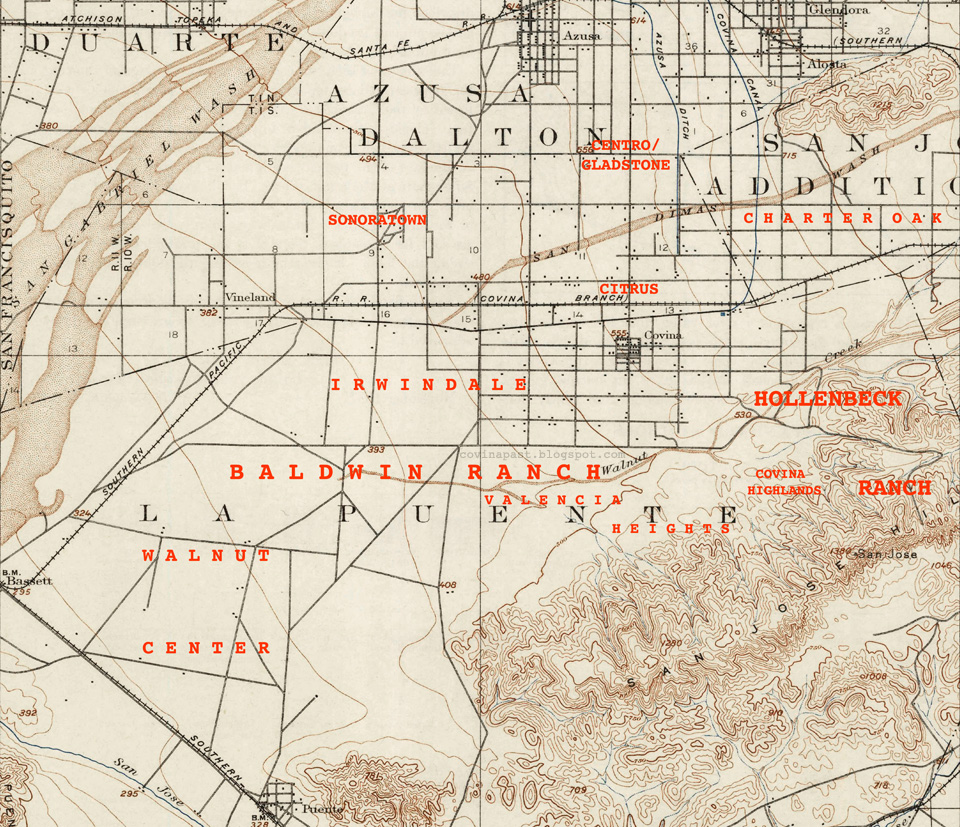The localities described below would have been household names to Covinans during the the town's first half-century, but most are unfamiliar today.

USGS map from 1908 showing Covina and environs in the early 20th century. (Note the original alignments of roads in the area of present-day West Covina.)
Click on the image for an enlargement.
Alosta – A railroad boom town south of Glendora. Born 1887, died 1888, it was subsequently absorbed by its thriving neighbor.2
The Baldwin Ranch – E. J. "Lucky" Baldwin (1828-1909) acquired this ~18,000-acre tract in old Rancho La Puente after the original owner, William Workman (1802-1876), defaulted on his mortgaged debts and killed himself.3 The Baldwin Ranch comprised most of the land south of today's Interstate 10, east of the San Gabriel River, and north of the Puente and San Jose Hills, encompassing the present-day cities of West Covina, Baldwin Park, part of the City of Industry, and the unincorporated community of Hacienda Heights.
Centro/Gladstone – Located at Citrus and Gladstone Avenues (the latter then called Broadway), this crossroads was so-named because it was considered the center of the Azusa Valley. A general store was built there in 1878, followed by a post office in 1885. In 1887, the "city" of Gladstone was founded at Centro but it very soon failed. Gladstone's abandoned hotel later served as the valley's first high school, and lent its name to today's familiar east/west arterial street between Glendora and Covina.4
Charter Oak – Still extant, obviously, but as defined geographically, Charter Oak was that portion of Henry Dalton's Rancho San Jose Addition that lay west of San Dimas and east of the range road (Grand Avenue) separating Range 10 West and Range 9 West in Township 1 South, San Bernardino Meridian.
Citrus – A pioneer outpost founded in 1877 by Eugene Griswold at the intersection of Citrus Avenue and what was then called the Azusa Cañon Road (Cypress Avenue today). (Yes, Citrus Avenue existed before Covina did!) Somewhat prophetically, Griswold named the place "Citrus" before there was any local citrus industry to speak of. Also sometimes referred to as "Citrus Corners," it was home to the first post office in the Lower Azusa Valley.4
Covina Highlands – The first residential development in the hills south of Covina opened in 1929. Initially promoted as the east valley's answer to Beverly Hills, the 2- to 12-acre rancho lots5 attracted wealthy buyers. In the mid-Fifties, two attempts were made to incorporate the area,6 but both cityhood moves failed.
The Hollenbeck Ranch – Initially a 5,563-acre tract in Rancho La Puente owned by John A. Rowland (1791-1873), it was purchased by the Costa Rican Badilla brothers in 1876 for a coffee plantation. J. Edward Hollenbeck (b.1829) acquired the entirety of the tract in 1879, and in 1882, he partnered with J. S. Phillips (1840-1905) to subdivide a 2,000-acre portion which three years later became Covina. Hollenbeck died in 1885, but the expanse of range land he owned in the eastern San Jose Hills retained his name for decades to follow.
Irwindale – The original Irwindale was a citrus-growing community due west of Covina.7 Its general boundaries were Azusa Avenue on the east, Orange Avenue on the west, Walnut Creek on the south, and Cypress Avenue on the north. Irwindale was the first station west of Covina on the Southern Pacific Railroad spur line.8 It was named after pioneer J. Frank Irwin, who drilled the first water well in that section in 1899.9
Puente – This earliest settlement in Rancho La Puente became the city of La Puente in 1956.
Sonoratown – Today's city of Irwindale, Sonoratown was the barrio where those of Mexican descent were designated to live in those racially-segregated times.4
Valencia Heights – In 1912, this eastern foothill portion of present-day West Covina became the last large tract of land in the area to open to citrus cultivation.10 Bounded on the west by Lark Ellen Avenue and on the east by Oregon (Grand) Avenue, many prominent local citizens built estates there, including Lark Ellen herself in 1929. The place-name fell into disuse as the city limits of West Covina expanded ever eastward in the 1930s.11
"Vineland of the Azusa" was the original tract name of Baldwin Park.12
Walnut Center – The farming community on former Baldwin lands that was first settled, irrigated and cultivated by Robert E. Dancer in 190513 expanded over the years to the north and east and eventually incorporated as West Covina in 1923. However, most of the area that folks at the time called Walnut Center currently lies in the unincorporated area of Bassett.

References:
1 USGS topographical map, Pomona, CA, 1904 (1941 ed.).
2 Pflueger, D. 1951. Glendora: The Annals of a Southern California Community. Saunders Press, Claremont, California, 262pp.
3 Spitzzeri, P. R. Baldwin’s Ranch, ca. 1900s, The Homestead Blog, January 14, 2018.
4 Pflueger, D. H. 1964. Covina: Sunflowers, Citrus, Subdivisions. Castle Press, Pasadena, California, 372pp.
5 Covina Argus, May 17, 1929, p.1.
6 Van Nuys News, October 8, 1957, p.6.
7 Covina Argus, October 5, 1907, p.11.
8 Los Angeles Times, January 2, 1898, p.6.
9 Covina Argus, July 25, 1903, p.1.
10 Covina Argus, June 15, 1912, p.2.
11 Covina Argus, April 19, 1929, p.1.
12 Official Map of the County of Los Angeles, California, 1898.
13 Covina Argus, August 1, 1908, p.2.
No comments:
Post a Comment
To post a comment, you must login to this page with the Google Chrome web browser. That is the only way that works now.